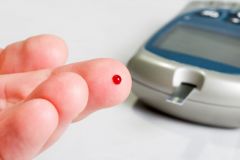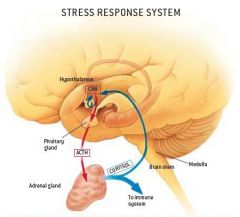![]()
![]()
![]()
Use LEFT and RIGHT arrow keys to navigate between flashcards;
Use UP and DOWN arrow keys to flip the card;
H to show hint;
A reads text to speech;
19 Cards in this Set
- Front
- Back

Rahe et al. (1972)
|
Rahe et al. (1972) gave the Social Readjustment Rating Scale to 2,700 sailors to calculate the number of life changes experienced in the last 6 months. Medical records for the following 6-month tour of duty were then scrutinised, from which individual medical scores were compiled. A significant positive correlation between SRRS scores and medical scores was found, supporting the idea of a link between life changes and vulnerability to illness.
|
|

Brady (1958)
|
Brady (1958) investigated whether the stress of receiving electric shocks would lead to stress-related illness in monkeys. Monkeys were run in pairs, both receiving shocks to the feet but one monkey (executive) was able to avoid being shocked by pressing a lever at the sound of the pre-shock warning signal.
After 23 days the 'executive' monkeys began to die of gastric ulceration. The yoked control monkeys, who received shocks but could not avoid them, remained healthy. Brady concluded that the shocks themselves were not as stressful as the attempts to avoid them. Having control was the stressful element in this study. Subsequent investigators have questioned Brady's findings, reporting conflicting results. Stressing monkeys (or any animals) until they die or become severely ill is highly unethical and would not be permitted today. |
|

Kanner et al. (1981)
|
Kanner et al. (1981) devised a hassles scale of 117 negative daily items and an uplifts scale of 135 positive items. One hundred participants were then studied over 12 months and it was found that daily hassles correlated with negative psychological symptoms and were a better indicator of illness than life changes. It was also found that life changes (e.g. divorce) led to daily hassles (e.g. having to cook, shop and clean for oneself) which then led to vulnerability to illness, suggesting that life changes and hassles interact to affect health levels.
|
|

Kiecolt-Glaser et al. (1995)
|
Kiecolt-Glaser et al. (1995) found that slight wounds given to female participants who had the stress of caring for senile parents took longer to heal than those without such stressors. This finding was backed up by other measures of immune system functioning which suggests that prolonged chronic stress reduces immune system function.
|
|

Cohen et al. (1993)
|
Cohen et al. (1993) found that, of participants exposed to the cold virus, those with high stress scores were more likely to actually develop a cold. This implies that stress decreases the efficiency of the immune system, creating a greater vulnerability to illness.
|
|

Friedman & Rosenman (1974)
|
Friedman & Rosenman (1974) measured the personalities of over 3,500 healthy middle-aged males over a 12-year period, with those scoring highly on impatience, competitiveness, motivation for success, frustration at goals being blocked and aggressiveness under pressure, being labelled as Type A personality and low-scorers as Type B personality. Twice as many Type A personalities developed cardiovascular disorders, suggesting that personality is a risk factor in developing stress-related illness and that psychological factors exert a biological effect on the body, as the negative biological effects of stressors are mediated through psychological personality factors. Thus stressors are not harmful themselves, it is how individuals perceive and react to them that negatively affects health.
|
|

Evans et al. (1994)
|
Evans et al. (1994) found that short-term (acute) stress actually benefits the immune system, as students who gave mildly stressful public talks displayed increased levels of sigA, an antibody that enhances the ability of the immune system to resist infection.
|
|

Marmot et al. (1997)
|
Marmot et al. (1997) used questionnaires and health screenings to find that civil servants with low job-control were three times more likely to have heart attacks than those with high job-control, implying that low job-control is harmful to health. However, Marmot found no correlation between workload and stress-related illness, which contradicts Johansson’s (1978) findings. As Johansson focused on jobs that required continuous concentration, his findings may be a more valid measure of high workload.
|
|

Holmes & Rahe (1967)
|
Holmes & Rahe (1967) examined the medical records of 5,000 patients, finding 43 common life changes which occurred prior to onset of illness. These life events were given ratings relating to how stressful they were perceived to be by 100 judges, the resulting scores being called life change units (LCUs) which made it possible to calculate the amount of stress an individual experiences in a given amount of time. Individuals with high LCU scores for the preceding 12 months had a heightened likelihood of experiencing illness in the following year. For example those with LCU scores of over 300 had an 80% chance of developing illnesses like diabetes, heart conditions and cancer. The research suggests that it is possible to measure stress objectively as an LCU score and that life changes are linked to stress-related illnesses.
|
|

Taylor et al. (2000)
|
Taylor et al. (2000) found that acute stress produces the ‘flight or fight’ response in men but the ‘tend and befriend’ response in women because women produce more oxytocin, a biochemical that produces relaxation and nurturing. This suggests a gender differences in the activation of the sympatho-medullary pathway.
|
|

Kobasa (1979)
|
Kobasa (1979) found that highly stressed executives with low levels of illness had higher levels of hardiness than highly stressed executives with high levels of illness. This suggests that hardiness helps to protect against stress-related illness, a notion supported by Dreher (1995) finding that hardiness reduced illness by enhancing immune system function, which implies hardiness has a mediating effect upon stress.
|
|

Davidson (1993)
|
Davidson (1993) found that 78% of patients with social-anxiety disorders improved with drug treatment, compared to only 20% given a placebo treatment. A 2-year follow up found more effective functioning in those treated with BZs (benzodiazepine drugs), demonstrating them to be effective as a long-term treatment.
|
|

Kiecolt-Glaser (1984)
|
Kiecolt-Glaser (1984) took blood samples from students sitting stressful examinations and asked them to complete questionnaires. She found increased immunosuppression (measured by the amount of killer cell activity, a special type of leucocyte), especially in those scoring high on loneliness, stressful life events and psychiatric symptoms such as depression. This suggests that stress is linked to decreased immune system functioning, especially in individuals exposed to certain types of stressor.
|
|

Newcomer et al. (1999)
|
Newcomer et al. (1999) found that participants given cortisol in sufficient quantity to produce blood sugar levels similar to people undergoing major stress had a much reduced memory ability compared to participants given only sufficient cortisol to produce blood sugar levels that mimicked minor stress. This supports the idea that activation of the pituitary adrenal system incurs impaired cognitive functioning.
|
|

Maddi et al. (1998)
|
Maddi et al. (1998) found that following hardiness training managers had increased hardiness and job satisfaction, while simultaneously displaying a decrease in severity of illnesses. Hardiness training also proved to be more effective than relaxation strategies and meditation, which suggests it is highly effective and can be learned.
|
|

Sher (2004)
|
Sher (2004) found hassles were associated with heightened cortisol levels in healthy individuals and that increased cortisol contributed to the onset of depression in vulnerable individuals. This suggests that it is increased levels of stress hormones, due to hassles, which negatively affect health.
|
|

Krantz et al (1991)
|
Krantz et al (1991) investigated the relationship between stress & cardiovascular disorders.
Cardiovascular patients demonstrated the greatest myocardial ischemia during the mental task, and also had highest increases in blood pressure. The control participants showed lowest levels of myocardial ischemia and blood pressure increase whilst performing tasks. An intermediate group who had mild health concerns or none at all showed only moderate increases in blood pressure. These findings support a link between performing mild mildly stressful cognitive tasks and physiological activity that could damage the cardiovascular system. Not all people react in the same way so there are individual differences, which should be accounted for. |
|

Greer & Morris (1975)
|
Greer & Morris (1975) found that women with breast cancer suppressed their emotions more than women with non-fatal breast disorders, due to emotional suppression that led to a reduction in the efficiency of the immune system to resist disease. This was supported by Morris et al. (1981) finding that Type C women had an increased risk of developing cancer, which suggests that it is not just men who are prone to personality-related stress disorders. Further support came from Temoshok (1987) finding Type C personalities to be cancer prone, having problems expressing positive emotions and suppressing or inhibiting negative emotions, and Weinman (1985) who found that Type C personality traits influenced the progression of tumours and survival times.
|
|

Denollet et al. (1996)
|
Denollet et al. (1996) found that 53% of cardiac patients displayed Type D personality characteristics, which suggests the personality type is linked to an increased vulnerability to heart attacks. This was supported by Denollet et al. (1998) finding that Type D personality was associated with a 400% increased risk of sudden cardiac death, which was independent of other known risk factors, like smoking.
|

